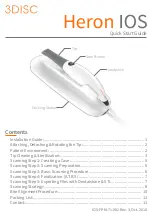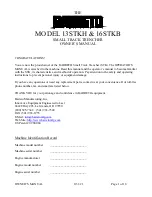
Materials Testing Machine
Operation
10
012-13762D
ture of tested samples can be measured, recorded, and ana-
lyzed.
Cast Beam Spares Kit (ME-6983)
The Cast Beam Spares Kit includes 30 “Rebar” members
and 10 “molds”. A Cast Beam consists of a beam that is a
model of the reinforcement bars (“rebar”) used in construc-
tion, and a mold that is used to produce a model of a beam of
reinforced “concrete” or prestressed “concrete”. A mixture
of fine sand, plaster, and water is poured into the assembled
rebar beam and mold. After the mixture hardens and the
mold is removed, the beam can be used as a #4 beam in any
PASCO Structure Set, or tested on the Materials Testing
Machine.
The illustration shows a Cast Beam with the Materials Test-
ing Machine and the Four-point Load Anvil attached to the
Bending Accessory.
Photoelastic I-Beams (ME-7011)
The Photoelastic I-Beams are similar to the #3 I-Beams and
#4 I-Beams that are part of the PASCO Structures Systems
(such as the Truss Set, ME-6990). However, the Photoelastic
I-Beams differ in that they are clear polycarbonate plastic
and do not have any holes in the web area of the beam. They
can be mounted on the Materials Testing Machine using the
Materials Structures Beam Adapter. When viewed with the
Materials Photoelasticity Accessory, the distribution of stress
in the beams can be studied.
The set includes twenty-four each of the two sizes of
I-beams. The #3 I-Beam is 11.5 cm long, and the #4 I-Beam
is 17 cm long.
Thin I-Beams (ME-7012)
The Thin I-Beams set consists of 48 thin I-Beams of two
sizes: #3 Beam (24) and #4 Beam (24). The beams are like
those in the PASCO Structures Systems, but there are no
holes in the web area. Therefore, when used with the Materi-
als Testing Machine, the test results are more like the results
would be for the type of metal I-Beam used in construction.
Maintenance
Regular maintenance for this equipment is minimal. The
leadscrews need to be kept clean, and they may need to be
re-lubricated at some point. Use a food grade anti-seize
grease containing PTFE (polytetrafluoroethylene, commonly
known as Teflon®).
If problems arise with the Materials Testing Machine, notify
PASCO scientific. It is not recommended that you attempt to
fix this equipment yourself. (See the Technical Support
information at the end of this manual.)
Specifications
Experiment Guide
NOTE: An Experiment Guide in electronic format is avail-
able to download from www.pasco.com. The Experiment
Guide includes information about the calibration procedure
and also describes the available Capstone Workbook files for
the Materials Testing Machine.
Enter “Materials Testing System” in the Search window and
look for the downloadable file(s) under “User Resources”.
The list of Capstone Workbook files for the Materials Test-
ing Machine includes the following. Each lab is available as
Rebar Member
Mold
Item
Description
Load Cell capacity
7100 N (1600 lbs)
Load Cell maximum
100% of capacity
#3 Beam
#4 Beam




































